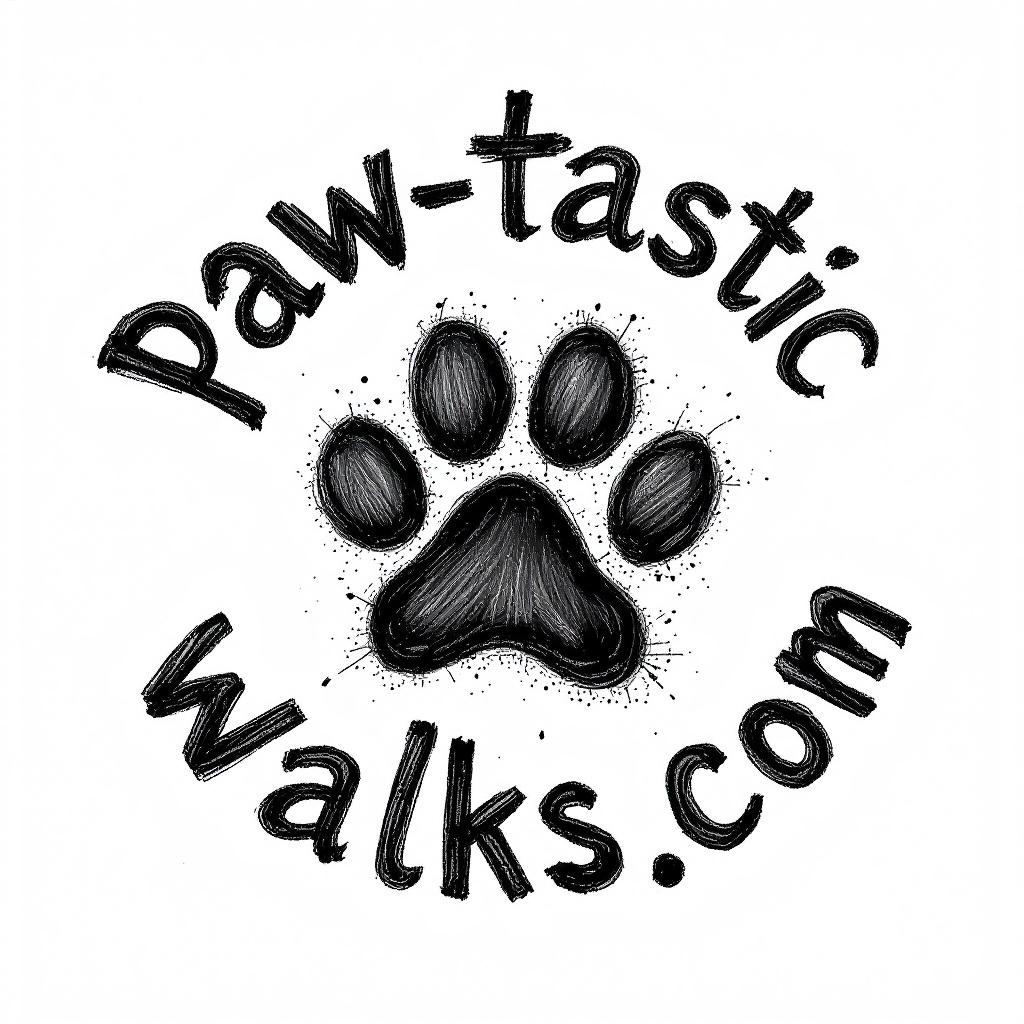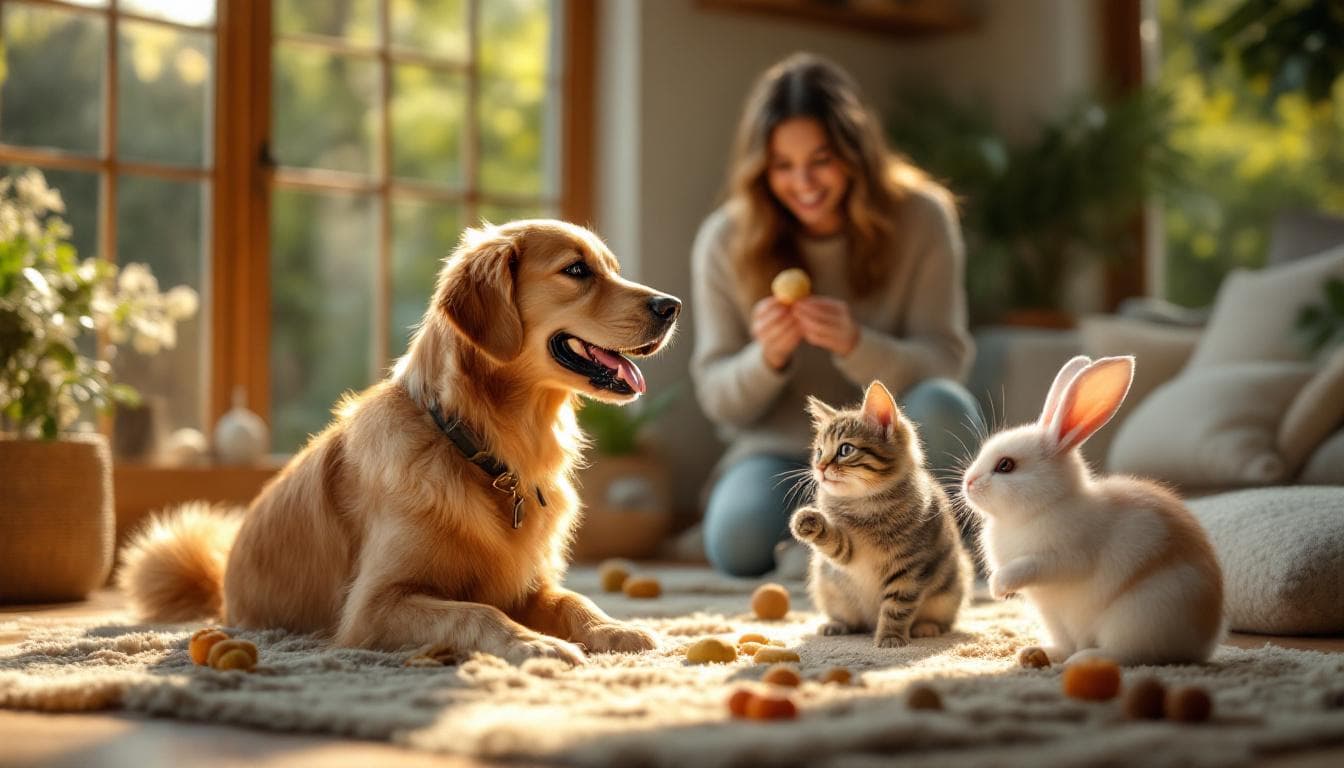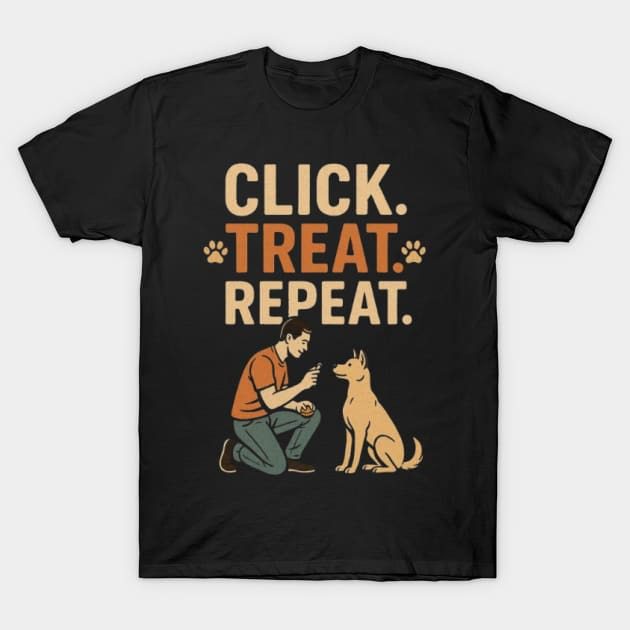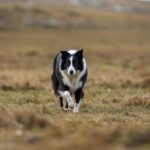Helping Your Dog Get Along With Other Pets with calm intros, safe meetups, and clear cues.
Get training tips, body language basics, and stress-free routines.
Many dogs, even the friendliest ones, may find new animals stressful.
It’s perfectly normal for some to feel unsure or protective, especially if they haven’t met many other pets before.
For local dog owners in East Cornwall, success starts with patience and smart planning.
Dogs may react to other animals for all sorts of reasons—old habits, breed instincts, or just nerves.
Using group dog walks, daily dog walks, and reliable dog walking services gives your dog gentle chances to meet new faces and learn calm behaviour.
A professional dog walker can support you and your pet every step. With a good plan and expert guidance, you can ease the tension and build trust between your dog and other animals.
If you’re searching for “pet walking near me” or want more advice on socialising alongside other pets, dog exercise services and puppy walking services can help—plus you’ll likely find your dog happier and more relaxed at home.
Dog walking rates and service details vary, but your local options open the door to more than just exercise. Safe walks and expert help give you peace of mind.
To find a caring, community-minded dog walker or learn more, try reaching out to Paw-tastic Walks’ dog walking team. You’re not alone—friendly support is always nearby. For more background on dog behaviour, see the Dog behavior Wikipedia page.

Understanding Why Dogs Struggle with Other Pets
Bringing a new four-legged friend into your home isn’t always a walk in the park.
Many loving dog owners feel puzzled when their dog struggles to get along with other pets—even after several play dates or group dog walks.
Helping your dog get along with other pets can require both patience and creativity, especially if you’re hoping for that peaceful, happy household you see in glossy magazines.
Below, let’s explore why some dogs find it hard to mingle and how understanding these reasons can help you move forward with confidence.

Breed Instincts and Past Experiences
Every dog is unique, but their breed and upbringing play a big part in how they react to other animals.
- Herding breeds, like Border Collies or German Shepherds, might try to round up cats, rabbits, or even other dogs. It’s not spite—it’s in their DNA.
- Some breeds, especially those with strong hunting backgrounds, may see smaller pets as “prey” and act on instinct, even if there’s no danger.
Negative past experiences can also shape behaviour. A dog that has been startled or attacked by another animal in the past may feel defensive or nervous when meeting new pets.
For rescue dogs or those with a history of limited social contact, gentle introductions over several short sessions can help.
Want to know more about helping dogs settle after a big change? Check out this helpful rehoming a dog guide.
Socialization and Missed Opportunities
Socialisation shapes whether your dog feels calm and confident around new faces—furred, feathered, or otherwise.
Pups who missed out on positive early social experiences often find other pets confusing or overwhelming.
This isn’t about blame, but about providing new, gentle opportunities for practice.
Even adult dogs can make progress, especially with structured support from professional dog walkers or through group dog walks.
Early and ongoing socialisation matters for all breeds. It’s the difference between a dog that shrugs off new sights and one that paws anxiously at the lead on every walk.
As noted on the Dog behavior Wikipedia page, social experience is central in shaping behaviour, right alongside genetics.
Territorial Feelings and Resource Guarding
Does your dog bristle or bark when a new animal walks into “their” lounge or garden?
Territorial feelings are common and totally natural. For many dogs, their home is their safe haven—so it’s not surprising they sometimes feel put out by a new arrival.
Resource guarding is another culprit. If your dog stiffens up or growls near their bed, food bowl, or favourite toys when another pet is close, they’re probably worried about losing something they love.
Group dog walks, daily dog walks, and dog exercise services can help your dog learn to share space with others in a controlled way, away from their “treasures.”
Anxiety, Overexcitement, and Body Language
Dogs often communicate with their bodies long before a bark or a growl. Some dogs are so keen to play, they rush up to new pets with wild enthusiasm, which can make others feel threatened or overwhelmed. Others freeze or hide, unsure how to react.
Recognising these signals lets you step in early, reducing stress for everyone.
Practice makes progress. Calm and patient guidance, with the help of a reliable dog walker or structured puppy walking services, helps most dogs relax over time.
Helpful tips and further reading can be found in this guide on socializing your dog.
The Role of Routine and Professional Support
Sudden changes can send even the bravest dog into a spiral. That’s why sticking to regular routines and short, managed meetups often works best.
Consistency builds confidence. Many East Cornwall owners lean on local dog walking services to add these positive encounters into their dogs’ lives.
If you notice stubborn issues, such as snapping, lunging, or trembling, a professional dog walker trained in behaviour can make a big difference. Planned group dog walks or lessons with an expert offer gentle, repeatable practice.
Common Reasons Dogs May Struggle
| Factor | What It Looks Like | Ways to Help |
|---|---|---|
| Breed instincts | Herding, chasing, barking | Controlled group walks, structured introductions |
| Lack of socialisation | Hiding, fear, nervousness | Begin slow interactions, seek puppy walking services |
| Past trauma | Fear, avoidance, aggression | Use calm routines, enlist a professional dog walker |
| Territorial/resource | Growling, guarding objects | Neutral meeting spots, regular daily dog walks |
| Overexcitement | Zoomies, barking, jumping | Teach basic cues, encourage calm greetings |
Every step toward helping your dog get along with other pets brings you closer to a calmer, happier home.
With time, patience, the right dog walking services, and a sprinkle of good humour, most dogs learn to accept—or even adore—their new furry housemates.
Preparing Your Home and Setting Everyone Up for Success
Getting ready to help your dog get along with other pets starts at home. A thoughtful setup can lower stress, ease tensions, and make daily life happier for everyone—two-legged and four-legged alike.
Let’s make your space safe and calm, and set good routines so your pets can find their groove together.

Setting Up Neutral Spaces
Dogs feel safest when they have their own spots. When you’re helping your dog get along with other pets, it’s smart to give each animal a separate area.
Use baby gates or separate rooms if you can. These boundaries give your dog and any new arrivals time to sniff, observe, and build trust without feeling pressured.
- Create safe zones: Each pet should have a bed, water bowl, and a spot they can retreat to, away from others when things feel overwhelming.
- Avoid “territory battles”: Let first meetings happen in shared or neutral parts of your home, not right by food bowls or favourite sleeping spots.
If introducing a dog with a known guard instinct, such as a Dachshund, it helps to follow advice from guides like this on dachshund suitability for families.
Managing Routines and Expectations
Consistent routines make pets feel safe, especially during big changes. Dogs thrive on knowing what to expect.
Predictable feeding times, regular daily dog walks, and clear rules help ease nerves.
- Stick to a walk and meal schedule: Try to keep mealtimes and walks on a steady routine so your dog feels secure, even as the household shifts.
- Limit big surprises: Bring in new toys a bit at a time, and don’t move sleeping/feeding spots around more than needed.
If you’re scheduling group dog walks, plan them after initial introductions at home.
This helps your dog associate outdoor time with positive, low-risk interactions.
Preparing Gear and Reducing Risks
A safe home setup goes beyond just beds and bowls.
Preparing your home also means thinking through gear and basic safety for smoother meetings.
- Use sturdy leads, harnesses, and ID tags for supervised intros and walks.
- Pick up or put away high-value chews and toys during first meetings; it’s easy for even sweet dogs to guard their favourite tug toys.
- For local East Cornwall outings, a well-fitted harness will keep introductions on walks calm and safe.
If you have small kids or vulnerable adults at home, teaching gentle handling and calm voices helps, too.
A calm home environment supports everyone—pets included.
Minimizing Triggers and Watching Body Language
Watch for things that might cause tension—like loud noises or too many people crowding close.
Lower stress by keeping things quiet during first meet-and-greets. Guide kids and adults to give pets space.
Look out for these signals during early introductions:
| Pet Body Language | What It Means | What To Do |
|---|---|---|
| Yawning, lip licking | Feeling unsure or nervous | Slow down, offer more space |
| Stiff posture | Alert, possibly uncomfortable | End or pause the interaction |
| Tail wag (high, stiff) | Aroused, excited (not always friendly) | Redirect with calm walking or treats |
| Soft gaze, relaxed body | Comfortable and happy | Praise and offer gentle petting |
For more on supporting shy or anxious pets, see tips on anxiety treatment for dogs.
Setting Up for Walks and Shared Play
Walks and play are where relationships grow. Start with parallel daily dog walks using separate leads.
Let the pets get used to seeing and smelling each other outside, before close-up playtime indoors.
- If possible, arrange a meet-and-greet with a professional dog walker. An experienced walker can support gentle introductions and watch for tricky signals.
- Pick quiet times for early group dog walks; too much excitement or strange dogs can make things harder at first.
- Remember, some breeds or nervous dogs need lots more alone time or slower pacing—guide your approach and go at their speed.
Interested in matching walk routines to breed quirks? Learn about walking with English bulldogs for breed-specific advice.
House Rules: Keeping Everyone on Track
Lay out clear “house rules” for humans and pets alike. Simple is best. Everyone—kids, grandparents, visitors—should know to:
- Never hover over a nervous dog or corner a new pet.
- Offer treats calmly, without loud greetings.
- Give space if a pet hides, growls, or walks away.
Don’t forget, dogs watch us closely. Gentle, relaxed humans help set the tone for happy, safe introductions.
For more foundational tips, see this guide to dog training secrets.
When to Call in a Pro
If you run into trouble—whether it’s growling, hiding, or constant pacing—getting help from a reliable dog walker can make a world of difference.
A seasoned pro spots potential trouble before it grows and adds calm confidence to your meet-and-greets. Ask about local dog walking rates to plan extra support as needed.
Curious about the science behind dog behaviour and socialisation? The Wikipedia page on ethology offers helpful background on how animals communicate and share their space.
Setting up your home can take a little extra effort, but it’s worth it when your dog starts making friends with furry housemates.
Small changes now pay off in calm walks, happy pets, and a house full of wagging tails.
Building Positive Relationships: Training and Socialisation Tips
Helping your dog get along with other pets often means taking things step by step.
There will be ups and downs along the way, but with thoughtful training and the right support, you can create a friendly, low-stress environment for all your pets.
Local resources, a positive attitude, and practical strategies make a big difference.
Let’s explore how to handle the tricky moments that come with socialisation and multi-pet introductions.
Dealing With Common Challenges and Setbacks
It’s normal for even the sweetest dog to hit a few bumps when meeting new pets.
Barking, resource guarding, and anxious body language are part of the journey.
If you’ve ever searched for a “pet walking near me” and felt uncertain about first introductions, you’re not alone.
The key is patience—progress doesn’t always happen overnight.
Why do these hiccups happen?
- Barking starts when dogs feel nervous, protective, or just overwhelmed by a new situation.
- Resource guarding shows up if a dog feels a favourite toy or food needs protecting, especially from a stranger.
- Nervousness is natural, and many dogs just haven’t had enough positive experiences with other animals yet.
Here are some approachable ways you can smooth out these common challenges:
- Keep first meetings short and positive. Quiet rooms or garden spaces work best.
- Try parallel daily dog walks. Let your dog and the new pet walk together but with space between them. This reduces direct tension.
- Use neutral territory. Meeting in places neither animal feels is “theirs” lowers defensive behaviour.
- Remove high-value items like favourite beds or tug toys during introductions. Less temptation means fewer arguments.
- Watch body language. If you notice stiff posture, yawning, or backing away, give both pets a break.
Setbacks can happen at any stage. If a dog barks at a new friend or guards their food, it doesn’t mean you’ve failed.
Improvement is about repetition and calm confidence—not a perfect first meeting.
What should you do if you run into trouble?
- Pause and slow down. Take a break and return to easier interactions, like walking side-by-side.
- Reward calm behaviour. Treats and gentle praise are more encouraging than correction.
- Stay consistent with routines. Dogs take comfort in familiar schedules, especially when big changes are underway.
If the challenges don’t improve or you feel safety concerns, it’s smart to reach out.
Local resources in East Cornwall, such as experienced behaviourists, can offer tailored advice.
Friendly trainers at places like Cornwall Dog Training Club provide classes for all ages, where dogs learn to be more confident around new faces.
A reliable dog walker is your extra set of hands and eyes during introductions. Professional dog walking services often manage group dog walks, easing pets into social settings in a way that’s safe but not overwhelming.
They’ll know what small signals to watch for and help prevent tense moments before they start.
If you need direct support, these East Cornwall options can help:
- Paws to Train and Behaviour – Pensilva offers sessions with a qualified canine behaviourist.
- Keltic Kymber Dog Training provides reward-based training programs for all breeds.
- Woof N Hoof Dog Behaviourist uses positive reinforcement in their local behaviour support.
For ongoing problems—such as aggressive lunging or fights—don’t wait. Get in touch with a professional as soon as possible, especially if either pet’s safety is at risk.
Sometimes, group dog walks and puppy walking services give you steady, gentle practice in a community setting.

Common Problems and Quick Solutions
| Challenge | Real-World Tip | When to Seek Extra Help |
|---|---|---|
| Barking at new pets | Lower excitement, use parallel walks | If barking leads to aggression |
| Resource guarding | Remove prized items, use neutral spaces | If guarding escalates or causes fights |
| Nervousness/shyness | Keep sessions short, positive, and relaxed | If your dog is panicked or cannot settle |
| Escalating tension | End the session before tempers flare | If risks to safety appear |
The journey is always better together. Learn from others’ experiences, such as how group walks can help nervous Basset Hounds or explore tips for owning a Dachshund where structured socialisation makes a difference.
Outside support is just part of the toolkit. Sometimes a professional dog walker, training club, or behaviourist is the best route—especially when introductions feel stuck.
Socialisation is not a contest; it’s a long, gentle walk together.
For a comprehensive understanding of how dogs experience social situations and form relationships, the Wikipedia page on dog behavior is a good read.
In East Cornwall, you’ll find:
- Group classes for all ages and temperaments
- Experienced handlers available for daily dog walks and safe pet introductions
- Local communities open to sharing advice and a friendly word
For specialised, supportive help, consult Paw-tastic Walks about local dog walking rates, group dog walks, and tailored services. Their knowledge helps you build a safe, happy multi-pet home.
Helping your dog get along with other pets is about steady progress, praise for calm moments, and knowing where to find help if you need it.
With practice, patience, and the backing of your local community, most setbacks are a step forward in disguise.
Keeping Walks Safe, Fun, and Social for All Pets
Helping your dog get along with other pets does not stop at home; it continues every time you step outside.
Group dog walks, daily strolls, and park visits give your pets new ways to learn and enjoy life together. But fun and learning go hand-in-hand with safety and structure.
With the right planning, dog walking services, and expert advice, you can make every outing smooth, joyful, and social—for all your furry family members.
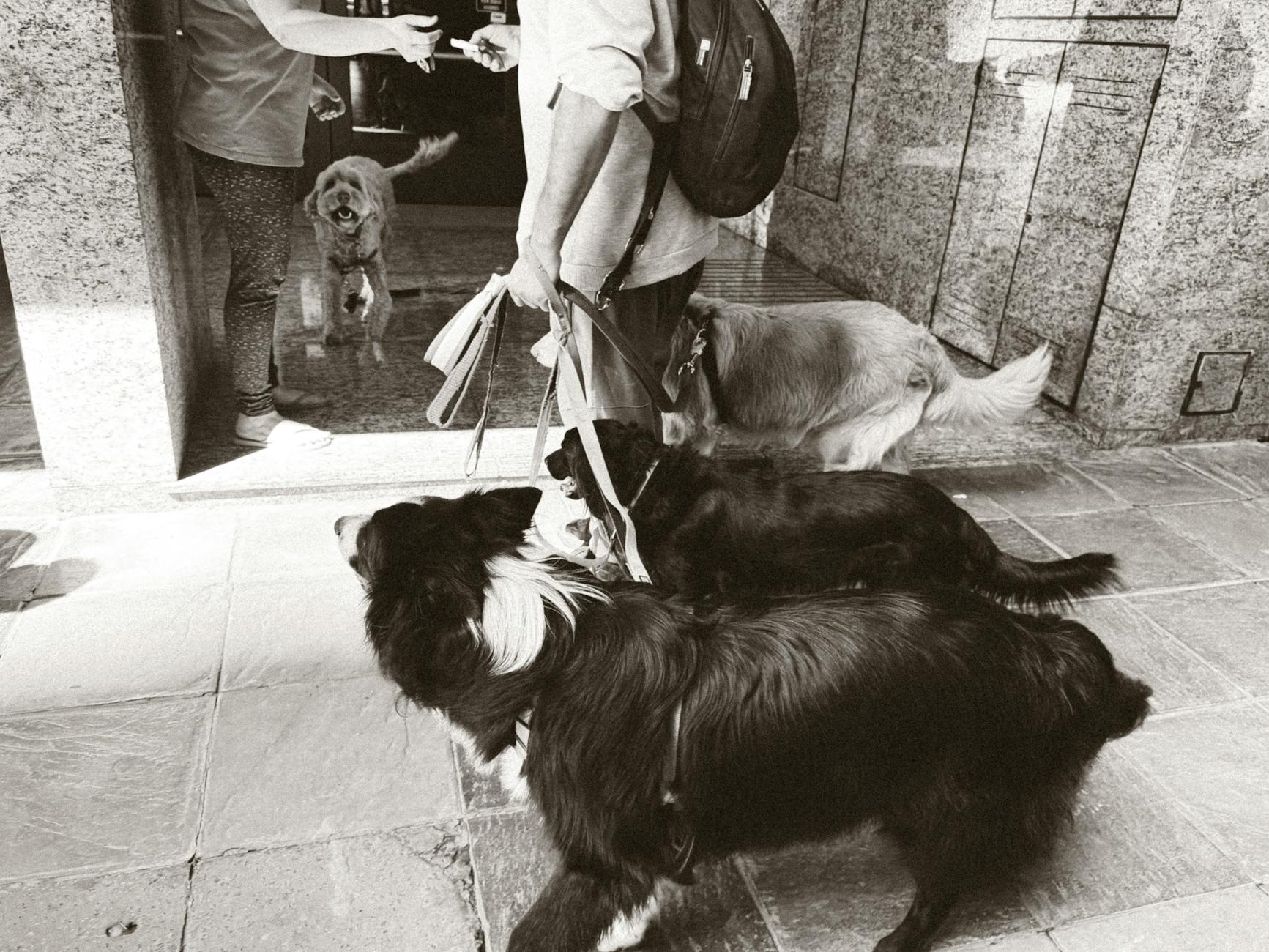 Photo by Marina Zvada
Photo by Marina Zvada
Setting the Tone: Confidence, Calm, and Consistency
Your attitude sets the mood for every walk. Dogs read our tone and body language, so staying upbeat and calm goes a long way. Keep greetings friendly but relaxed.
Routine daily dog walks build trust, letting dogs know what comes next. Simple rituals, like clipping on a harness or waiting at the door, help everyone feel ready for action.
If you’re managing several dogs or pets at once, preparation is everything:
- Use sturdy leads and harnesses sized for each pet. For large dogs, choosing a well-fitted harness makes outings safer and easier to manage.
- Start walks at the same time each day so pets anticipate a routine, not surprises.
- Keep a pocket of favorite treats for rewarding calm, happy behavior during social moments.
Group Dog Walks: Social Skills in Action
Group dog walks and playdates are brilliant for boosting social skills.
A professional dog walker often knows how to introduce new pack members smoothly, match personalities, and watch for warning signs that excitement is running too high.
Some benefits of group outings and dedicated dog exercise services include:
- Furry friends get time to play, sniff, and interact with others.
- Dogs learn polite greetings and how to share space.
- Owners get peace of mind knowing socialisation happens in a controlled setting.
In East Cornwall, many opt for group outings managed by reliable dog walkers who can balance play with safety.
As explained in more depth, monitoring group dynamic is key for safe and enjoyable outings.
Balance Fun and Boundaries
Keeping walks fun and social for all pets depends on setting clear boundaries. Some dogs dive right into play, while others prefer a quiet sniff or a little distance.
Both are perfectly normal! You can help foster good feelings by:
- Watching for body signals like stiff tails, raised hackles, or avoidance. These mean a break might be welcome.
- Steering clear of crowded areas or overwhelming off-lead parks in early days. Quiet corners offer better first meetings.
- Using tug toys (carefully supervised) can create positive distractions and help burn off nervous energy during rest stops.
If the weather is less than ideal, don’t let that stop your routine. Find handy advice on walking your dog in the rain, so your daily dog walks stay consistent and enjoyable.
Safety First!
Safety comes before everything else when socialising on walks. Even the most playful dog can get startled, and even gentle pets may need personal space sometimes.
Here’s how to boost safety for all:
- Always start introductions on-lead and in neutral territory.
- For outings with new dogs or pets, use longer double leads so everyone has room to move.
- Keep at least one emergency recall word or “emergency treat” ready to refocus attention if excitement flares.
- Regularly inspect collars, tags, and leads for wear and tear to avoid escapes.
- For extra peace of mind, using a GPS tracker for dogs helps if a nervous pet bolts or wanders off.
Professional dog walking services often have extra tips and strategies for preventing mishaps on the go.
Support for All Breeds and Backgrounds
Not every dog grew up running with a pack. Some rescues or shy pets need extra patience and understanding in social settings.
Using puppy walking services or small, tightly managed groups works well for building confidence at each dog’s pace.
If you’re dealing with a breed with strong guard or prey instincts, opt for smaller, skillful group dog walks or private walks at first.
Breed-specific tips, such as advice for walking Akitas, are handy for anticipating unique needs.
For a helpful background on how dogs form social bonds, their pack instincts, and typical animal group behaviors, the Wikipedia page on socialization in animals gives more detail.
Communicating With Your Dog and Others
Great social walks happen with teamwork—not just between dogs, but among the people.
Greet other walkers with a smile and a quick check-in: “Are your pets friendly?” or “Is it ok if our dogs say hello?” Respect “no, thank yous” with good humor and turn away calmly.
Teach children and visiting friends alike about safe greetings:
- Always wait for an invite before approaching an unknown dog.
- Approach calmly, with an open palm or closed fist for the dog to sniff.
- Watch dogs for signals of tiredness or need for space before fussing or petting.
For detailed strategies on social cues and safe introductions, these dog training secrets are well worth a look.
Dog Walking Services: Your Friendly Safety Net
Choosing a reliable dog walker is more than a time-saver—it’s a way to keep your walks safe, fun, and full of social learning.
Trained professionals know how to group compatible pets, handle surprises, and maintain positive energy while staying flexible.
When picking a dog walking service, consider:
- What kinds of outings best suit your pet? Solo, group, or puppy walks?
- How do dog walking rates fit your budget and routine?
- Can your walker give advice on fun routes, enrichment, and local parks or safe nature spots?
If you’ve searched for “pet walking near me” and want peace of mind, a professional dog walker brings skill, cheer, and experience to every walk.
Quick Reference: Checklist for Safe, Social Walks
| What to Bring | Why It Matters |
|---|---|
| Leads & Harnesses | Control and comfort for every pet |
| Poo bags | Keep walks clean and pleasant for all |
| Water bottles | Hydration, especially on warm or long walks |
| Treat pouch | Quick rewards for good manners and calm responses |
| Toys or tug toys | Fun distractions and bonding for dogs who need extra encouragement |
| Phone with GPS app | Handy in case of accidental runaways |
| High-visibility gear | Extra safety near roads, especially in low light |
Making walks positive and safe for every pet is a team effort—just like helping your dog get along with other pets.
With a dash of planning, a cheerful attitude, and the right local dog walking support, you’ll enjoy tail wags all around on every stroll.
Get this great shirt from our Paw Tastic Apparel Store!
Conclusion
Helping your dog get along with other pets is both a journey and a reward. When you mix steady routines, patient introductions, and support from experienced professionals, your household can become a friendlier place for every furry family member.
Celebrate the small wins, whether that’s a peaceful walk or a new shared nap spot, and keep a cheerful outlook as you go.
For local pet owners, teaming up with trusted dog walking services means you don’t have to sort it all by yourself.
Lean on options like group dog walks, daily dog walks, and puppy walking services if you want extra hands and expert advice.
If you ever think, “Where can I find a reliable dog walker or pet walking near me?”—there’s friendly help nearby, ready to encourage both you and your pets along the way.
Remember, every dog is unique. What works for one may not work for another, but with patience, laughter, and the right guidance, peaceful multi-pet homes really do happen.
If you need extra tips or support, don’t hesitate to ask for help. Building a happy pack starts with one step, one walk, and sometimes, one tug toy at a time.
Thank you for giving your pets the chance to shine together. For more guidance or to arrange professional support, explore more about dog walking services.
Small steps truly lead to big changes. If you’d like a deeper look at animal social behaviour, the Wikipedia page on animal communication is packed with extra reading.
Your confidence, warmth, and perseverance help create the calm, happy home every pet deserves.
